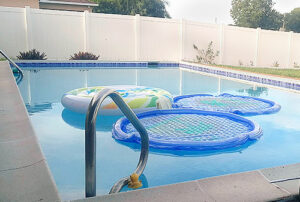Summary: Florida is the leader in drowning deaths of children 4 and under. Children can drown in 2 inches of water in 2 seconds. JACD, a non-profit organization, can help you keep your children safe. They provide free pool fencing for families with ungated water areas*, support swimming classes and spread drowning resources across communities. Read on for important safety tips.
When children drown: preventing the unthinkable
By Lianna Hubbard, Florida Weekly Correspondent
 Earlier this month, country singer Granger Smith stunned his fans when he announced that his 3-year-old son, River, had died in a drowning accident at home.
Earlier this month, country singer Granger Smith stunned his fans when he announced that his 3-year-old son, River, had died in a drowning accident at home.
It’s an all-too-common tragedy — one that Charlotte County resident Paul DeMello knows experientially. His twin 1-year-old boys drowned in January 2010, in an ungated backyard pool.
“I was so looking forward to the life I could have had with my twins,” he said. “I feel like I was cheated out of a lot of things.”
After his loss, Mr. DeMello began the Just Against Children Drowning Foundation (justagainstchildrendrowning.org), JACD being an acronym he created in honor of his boys, Justin and Christian DeMello.
“If my twins were here, I know the dad I would have been,” he lamented. “I would have spent all kinds of money and time on them. So this is what I do instead.”
JACD supplies family homes with free pool fencing and spreads drowning resources across communities. “If there’s a child in the home, we’ll fence it [the pool] off at no cost,” Mr. DeMello said.
The foundation also works in collaboration with local organizations such as the YMCA to supply children with swimming classes.
Child drowning is a major cause of death in the United States. In 2017, 3,700 people died from drowning — one in five people of whom were children under 15 years old. Drowning is the No. 1 cause of death in infants 1 to 4 years old, according to the U.S. Centers for Disease Control and Prevention. Most children drown in swimming pools.
And it’s an even bigger problem in Florida.
The Sunshine State is the leader in drowning deaths of children 4 and under. For that young age group, drowning is the leading cause of death in Florida, according to the Florida Department of Health.
“The number of children who drown in our state each year could fill three to four preschool classrooms,” according to the Florida Department of Health in Volusia County. “These drownings include deaths in swimming pools and other bodies of water; infants have drowned in bathtubs and even buckets.”
“I encourage people to be worried every time they’re around water,” Mr. DeMello said.
“Two seconds in 2 inches of water is all it really takes.”
Aside from ungated water areas and unsupervised children, there are also misconceptions and myths about drowning, itself, that lead to deaths.
If you go by what happens on TV and in movies, drowning involves kicking, flailing, screaming and calling for help.
But Dr. Francesco Pia has made it his life’s work debunking the myths. A former lifeguard who developed the “Pia carry” (a widely used method of rescuing a potential drowning victim), he has spent 45 years studying drowning accident causation and reconstruction for public and private aquatic agencies — and nearly that long lecturing on the issue to federal, state and local agencies.
“There are many misconceptions [about drowning] that existed back in the 1950s and 60s that continue today,” Dr. Pia told Florida Weekly.
His work actually began in 1959 when he worked as a lifeguard at Orchard Beach in the Bronx, New York City. He realized then that there was almost no training for lifeguards to identify a drowning person. When he became a lieutenant lifeguard in 1968, he filmed instances of drowning and rescue at the beach.
“The concept of drowning is silent,” Dr. Pia said.
“It’s assumed that when they see a drowning person, they will recognize it,” he explained. “That’s incorrect. People expect behaviors [that] the drowning person doesn’t have the ability to demonstrate.”
When people are drowning, they have an automatic response — a response that fails every time. They will extend their arms in front of them and attempt to push themselves up using the surface of the water. Their head will be tilted back and their mouth will be sinking above and below water.
Here’s the clincher: A drowning person is not able to wave his or her arms or call for help.
“Regardless of age, gender, height, weight, ethnicity — despite these variations — this is what happens when someone drowns,” Dr. Pia said.
He coined the term “instinctive drowning response” to describe these actions. In adults, IDR can keep a person alive for only 60 seconds before they drown.
In children ages 1 to 4 (the most at-risk age group for drowning), IDR presents itself differently.
A small child who is drowning will roll over horizontally with his or her face down in the water, while the arms will still be extended.“It looks as though they’re doing the dog paddle when they’re actually drowning,” Dr. Pia said.
And it only takes 20 seconds — seconds — for a small child to drown.
Unfortunately, misconceptions have continued since Dr. Pia shared his findings in the 1960s.
“Once the child gets into the water, they need to be supervised,” he cautioned.
That’s a warning Mr. DeMello understands, so he works tirelessly with his nonprofit to prevent drowning.
“For me it’s about being proactive,” he said. “It’s about keeping those little feet on solid ground. Why wait till they’re in the water?”

